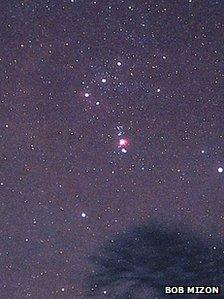Light pollution 'saturates' UK's night skies
- Published
- comments

Amateur stargazers were asked to study the Orion constellation
Half of the UK's population cannot see many stars because the night skies are still "saturated" with light pollution, campaigners have warned.
Some 53% of those who joined a recent star count failed to see more than 10 stars in the Orion constellation.
That had decreased only very slightly from 54% since 2007, the Campaign to Protect Rural England and the Campaign for Dark Skies said.
The problem remained despite attempts to curb street lighting, they said.
They said that in 2010, local authorities collectively spent more than 拢500m on street lighting, accounting for 5% to 10% of each council's carbon emissions.
A number of councils have tested schemes to switch off or dim street lights when they are not needed, although the trials have often proved controversial with residents.
Sleeping patterns
The information was gathered as part of the annual Star Count survey, which was held across two weeks in January and February this year.
Almost 1,000 people in different locations around the country took part.
Participants were instructed to pick a clear night to count the number of stars in the constellation of Orion.
Fewer than one in 10 said they could see between 21 and 30 stars, and just 2% of people had truly dark skies, seeing 31 or more stars.
Emma Marrington, a rural policy campaigner for the CPRE, says: "When we saturate the night sky with unnecessary light, it damages the character of the countryside and blurs the distinction between town and country.
"But this isn't just about a spectacular view of the stars; light pollution can also disrupt wildlife and affect people's sleeping patterns."
'Glaring lights'
Bob Mizon of the CfDS believes light pollution is a disaster for anyone trying to study the stars.
"It's like a veil of light is being drawn across the night sky, denying many people the beauty of a truly starry night.
"Many children growing up today will never see the Milky Way; never see the unimaginable glory of billions of visible stars shining above them," he said.
For the first time, national guidance has been issued by the government, to encourage local planning authorities to reduce light pollution through design improvements.
The National Planning Policy Framework, published at the end of March, states that by encouraging good design, planning policies and decisions "should limit the impact of light pollution from artificial light on local amenity, intrinsically dark landscapes and nature conservation".
Ms Marrington from the CPRE welcomed the move, saying poor excuses for bad or excessive lighting were heard too often.
"Of course we need the right, well-designed lighting in the right places - and some areas need to be lit for safety reasons - but there should not be a blanket assumption that glaring lights are needed.
"The evidence gathered during this year's Star Count Week shows that we need to take action now to roll back the spread of light pollution."
The Local Government Association, which represents councils, said local authorities were "well ahead of the game on this issue".
"Over the past two years scores of local authorities up and down the country have been trialling the switching off and dimming of street lights late at night in quieter areas," it said.
However, it added, public safety had to come first and councils would not cut lighting if a large number of people were strongly opposed to the idea and there were genuine safety concerns.
It added: "There is also a role for businesses to play in ensuring glaring lights and neon signs that light up the night sky are not left on unnecessarily."